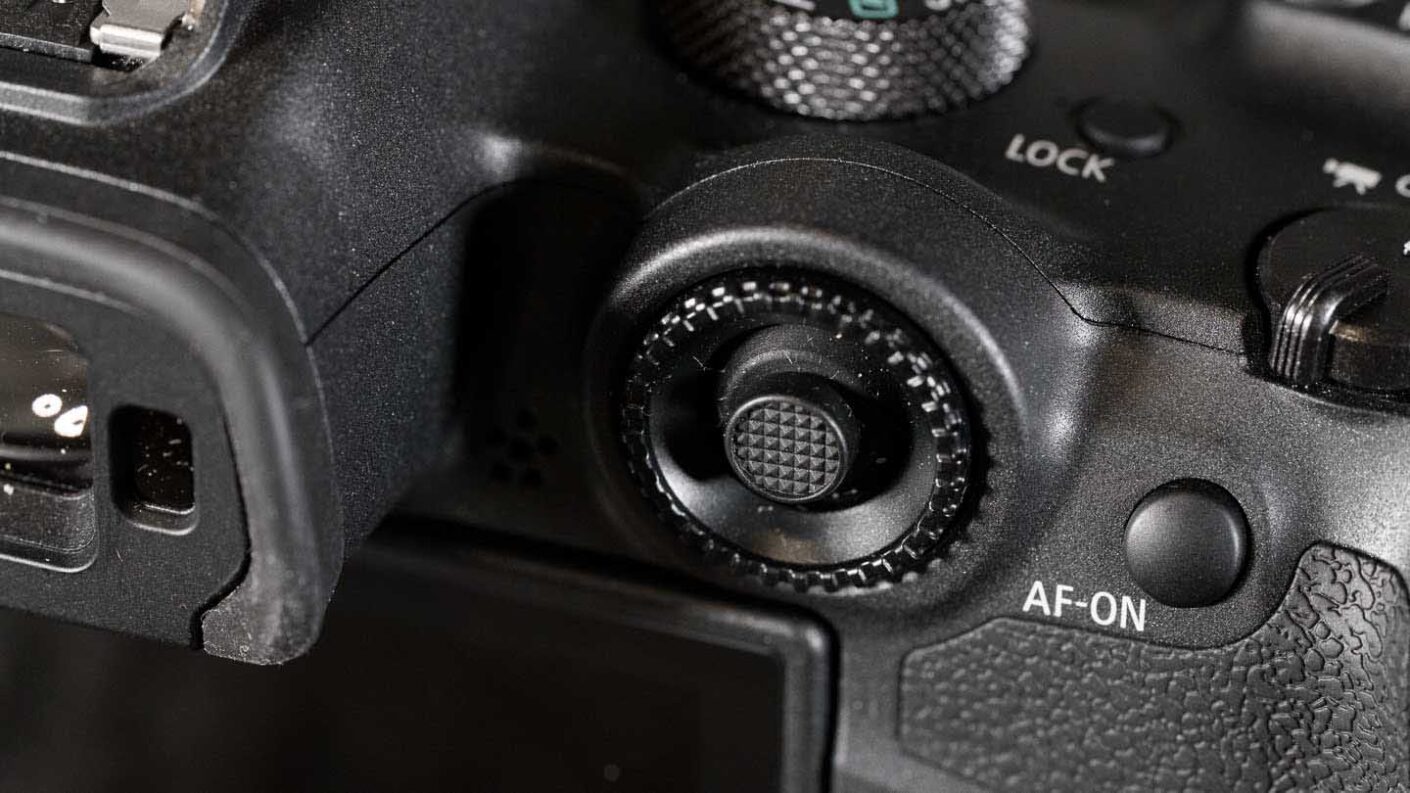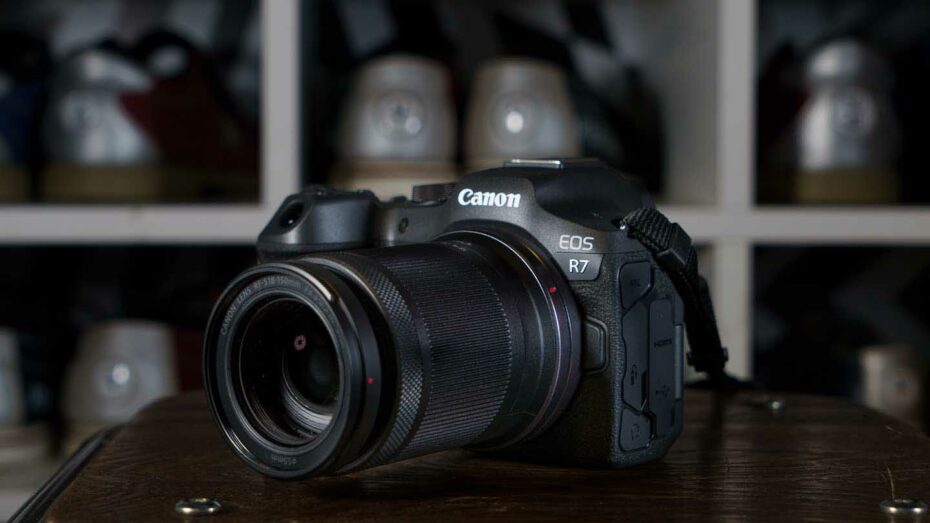Canon held the UK press briefing for the R7 in a bowling alley and ice-rink, neither of which were brightly lit – quite the opposite in fact. As if the gloomy conditions of the ice-rink weren’t challenging enough, the background was also very busy and the skaters were wearing black and red outfits that could be mistaken for it. Nevertheless, the subject detection system of the beta sample R7 proved very useful when photographing and videoing ice-skaters. It performed especially well when the RF 70-200mm F2.8L IS USM was mounted.
Switching to the RF-S 18-150mm F3.5-6.3 IS STM and shooting at 100mm or longer gave the camera more of a challenge because the maximum aperture dropped to f/6.2 or f/6.3, but it was still able to recognise the subject and get it sharp – especially when the skaters entered a poll of light. Helpfully, the boxes that appear in the viewfinder keep you informed about whether it’s seen the subject or not.
With the Subject detection set to ‘People’ and the Eye detection enabled, the R7 is quick to target the eyes when a subject is detected and turned towards the camera. And, crucially, it usually gets them sharp.
I shot with the R7 in the ‘Case A’ or ‘Auto’ AF configuration mode. This is sets the camera to adapt its tracking automatically to the subject movement. I found that the Canon R7 kept with the subject very well, only once jumping to another skater when they crossed over the path of my original subject, this can be improved by using the AF customisation options.
This impressive autofocus performance continued when I got hold of a full-production sample of the Canon R7. When shooting at a local wildlife park (Beale Park) with the EF 70-200mm f/2.8L IS USM II mounted via an adapter, the camera even proved up to the task of capturing sharp images of squirming otters. When they looked towards the camera it did a great job of recognising their eye and focusing on it. However, as I found with the Fujifilm X-H2S, it tended to latch onto an ear when their side profile was in the frame, despite an eye being visible.
Canon states that when the Subject detection and tracking is set to ‘Animal’, the R7 is capable of detecting, cats, dogs and birds. So otters are a bit of a stretch and it’s interesting to see what other animals are detected. Meerkats bodies and eyes were detected quickly, and lynx are a form of cat so it was no surprise that the camera took them in its stride. Ducks, owls and parrot-like birds presented little problem with their eyes being detected quickly, but it was less sure of rhea. And lemur eyes were spotted quickly, even when the animal’s face was almost in profile.
Although they were moving, the focus distance didn’t change very quickly with these subjects, but photographing my dog racing for a ball is a different matter. When shooting with the RF-S 18-150mm F3.5-6.3 IS STM on the R7, I found the camera was very quick to detect his eyes. However, examining my images reveals a slight delay in getting his eyes sharp so that the focus is on the far end of his body for the first couple of shots in a sequence shot at 15fps. It also lost the focus on his eyes now and again in the sequence. Switching to the EF 70-200mm f/2.8L IS USM II mounted via an adapter, gets the focus closer to the mark early on, but I still have a few images at the start of some sequences that aren’t quite sharp at the right point. Nevertheless, I still have some perfectly sharp images in each sequence shot with the two lenses.
While the Canon R7 isn’t quite as fast or as sensitive to eyes in the frame as cameras such as the Fujifilm X-H2S that have a stacked sensor, it’s still good – and of course it’s quite a bit more affordable. The subject-detection, and specifically the eye-detection, isn’t infallible, but it’s a very useful addition.
Checking the 4K video that I have shot during my testing confirms the R7’s autofocus prowess continues into video mode and hunting isn’t especially problematic.
I used a Lexar Professional 2000x SDXC UHS-II Gold Series memory card (maximum read/write speed 300/260MB/s) to enable the 15fps maximum continuous shooting rate with the mechanical shutter and 30fps with the electronic shutter and then 4K video recording with no problems.
I was able to record 65 raw and Jpeg (large best quality) images simultaneously in one sequence at 15fps. Switching to shoot just raw files enabled a sequence of 76-86 images, while shooting the best quality large Jpegs by themselves extended the burst depth to around 400 images – exceeding Canon’s claims. Activating the electronic shutter and shooting at 30fps enabled sequences of 50 raw files, 128 highest-quality large Jpegs, and 47 simultaneous raw and Jpeg files, again just beating Canon’s claimed figures.
Canon EOS R7 image quality
At low ISO settings the Canon R7 is capable of capturing a good level of detail. Noise is also controlled well as the sensitivity (ISO) setting is pushed up. However, I’d aim to make ISO 12,800 the maximum value I’d used as this strikes a good balance between the level of detail and noise (or the impact of noise reduction).
Comparing images shot at mid- to high-level sensitivity settings reveals that the Jpegs have less noise, but they also look smoothed at 100%. The raw files, however, have some luminance noise and more detail. It’s good to see that fine details are handled better in the Jpegs from the R7 than they are by the Canon 90D.
Dropping down from ISO 12,800 to ISO 3,200 sees a nice jump in the level of detail in Jpegs from the R7 while ISO 1,600 images look very good with just a hint of luminance noise in the shadows when viewed at 100% on screen and excellent levels of detail.
Canon EOS R7 IBIS performance
Canon claims a maximum shutter speed compensation of 7EV for the R7 with the RF-S 18-150mm f3.5-6.3 IS STM. I struggled to achieve this with the lens at its longest point. When shooting at 1/4sec, which is about 6Ev slower than you would normally expect to be able to use, around 50% of my images were acceptably sharp at full-size on a a 27-inch screen. Only around one in ten would pass muster at 100% on-screen.
I had to drop to a shutter speed of 1/15sec (4EV compensation) before I was completely happy with the results visible at 100% on-screen but my hit rate improved to around 90%.
In video mode, the IBIS worked well when I was standing still, handholding the camera, however, it can’t compensate fully for the movement of walking with the camera. Turning on the digital stabilisation improves the steadiness of the footage overall, but there’s the occasional dramatic jolt which makes it seem a little unnatural. I didn’t notice a significant when using the Digital Stabilisation’s Enhanced mode and there’s a significant crop.
The Auto level feature which is powered by the IBIS, works well in both stills and video mode. In both modes, the horizon levels smoothly within a couple of seconds and there’s no wobble or recoil visible.
Canon EOS R7 video performance
The Canon EOS R7 proves a capable video camera with features that are ideal for those with some experience of shooting video as well as relative newcomers. It’s great to be able to swap from stills to video mode with a flick of a switch and for the settings to be unique to each so you don’t have to reset your exposure settings etc every time.
Canon’s tabulated Movie recording size screen makes it easy to select mutually compatible resolution, frame rate and codec settings, and there’s a custom menu section where you can group together your most frequently used features.
Like the stills, the movies from the R7 show good colour with the auto white balance setting coping with most situations well. As mentioned earlier, the focusing system works well and usually follows a selected subject seamlessly.





